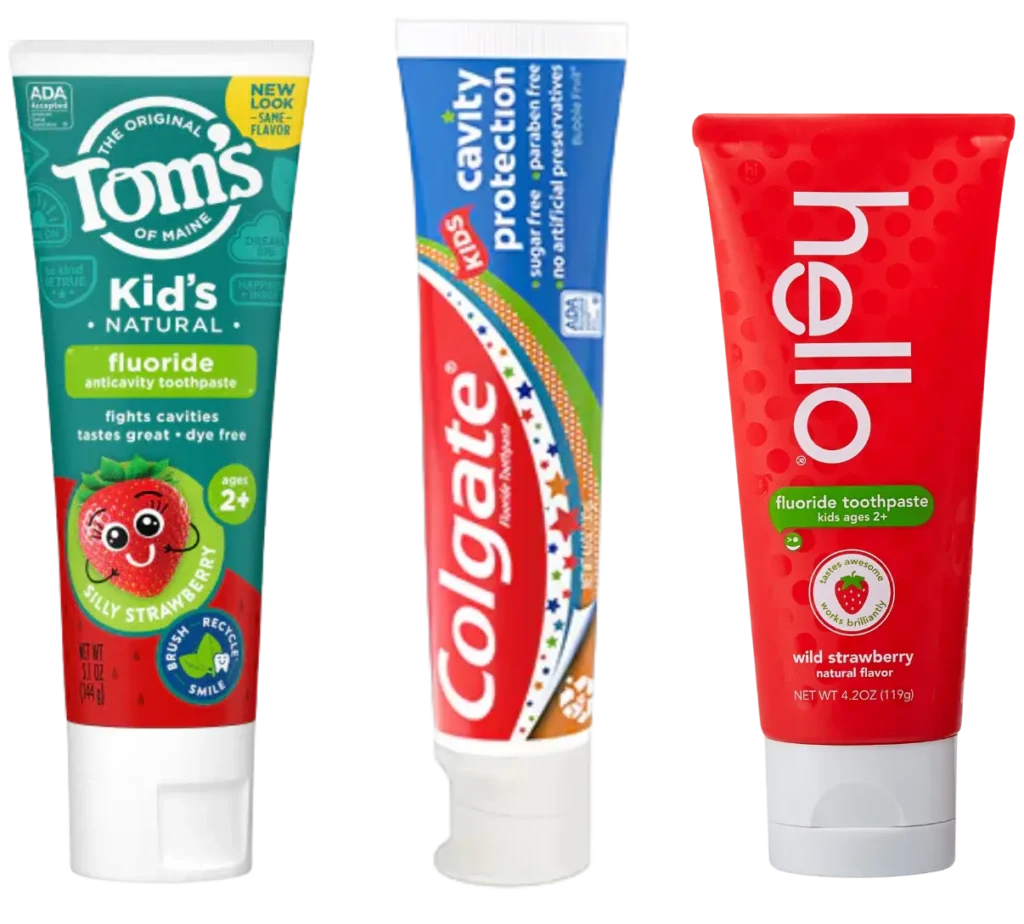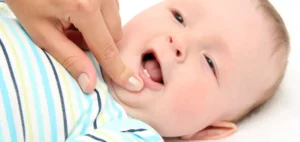Every parent wants their child’s smile to shine. But with so many kids’ toothpaste options on the shelf, how do you choose? The big debate nowadays is fluoride vs. hydroxyapatite. Both ingredients can strengthen teeth and help prevent cavities, but they work in different ways. In this friendly pediatric oral care guide from SPD, we’ll explain what each one does (and for whom) so you can pick the right toothpaste for your family. We’ll also share some top toothpaste picks for kids. Let’s dive in and make brushing fun and effective!
Fluoride: The Cavity-Fighting Champion
Fluoride is a time-tested mineral hero in dentistry. It’s found naturally in water, soil, and many foods, but most importantly in toothpaste and drinking water. When your child brushes with fluoride toothpaste, the fluoride ions are absorbed into the tooth enamel. This remineralizes the enamel – literally putting lost minerals back into the tooth, making it much tougher against acid attacks from cavity-causing bacteria. In short, fluoride helps harden and rebuild tooth enamel, stopping early decay in its tracks.
Dental experts (ADA, AAP, CDC, etc.) agree that fluoride is one of the most effective tools we have to prevent cavities in kids. It has decades of research behind it and a proven track record of keeping little teeth strong. In practical terms, using a fluoride toothpaste (with the right amount of fluoride) can mean fewer cavities and stronger enamel over time.
Of course, we use fluoride safely. We start fluoride toothpaste as soon as the first tooth appears, but only a pea-sized amount (or even a “rice grain” smear for toddlers) and always with parent supervision. This prevents too much fluoride from being swallowed. Used correctly, fluoride toothpaste is safe and very effective. (Yes, too much fluoride over time can cause faint white spots called fluorosis, but that’s mostly avoidable by using the tiny recommended dose and making sure kids spit out the excess.)
Bottom line: Fluoride toothpaste is the gold standard for pediatric oral care. It makes enamel stronger and can even reverse tiny early cavities. We at SPD gently push fluoride because we know it works – it’s the champion for cavity prevention.
Hydroxyapatite: Nature’s Tooth Builder
Hydroxyapatite might sound like a mouthful, but it’s actually simple: it’s the mineral your teeth are made of. Calcium hydroxyapatite (often just called HAP) is a form of calcium phosphate. It naturally makes up roughly 90–97% of tooth enamel. In other words, brushing with hydroxyapatite toothpaste is like giving teeth a little extra armor by directly adding enamel’s own building blocks back onto the surface.
When kids brush with a nano-hydroxyapatite toothpaste, those tiny mineral particles stick to the enamel, filling in microscopic cracks and scratches. This creates a protective mineral layer. In effect, it helps remineralize teeth just like fluoride does, but by providing the actual tooth mineral. It can reduce sensitivity and even gently whiten teeth, because it smooths and rebuilds the enamel surface.
One of hydroxyapatite’s biggest perks: it’s safe if swallowed. It’s the same stuff bones and teeth are made of, so our bodies are fine with it. For very young children (who often swallow toothpaste), or for families avoiding fluoride, a HAP toothpaste is a worry-free choice. There’s no risk of fluorosis with HAP. It’s also a great option if someone has a fluoride allergy or sensitivity.
However, HAP toothpaste is still relatively new on the market. It’s usually sold as a specialty “mineral” or “remineralizing” toothpaste. It can be a bit harder to find, and often costs more than regular toothpaste. Also, there are fewer long-term studies on it (though early studies are promising). In practice, hydroxyapatite is a gentle, more natural alternative that still helps rebuild enamel.
Bottom line: Hydroxyapatite toothpaste is a friendly, non-toxic way to strengthen enamel and reduce sensitivity. It’s especially appealing for little ones (and pregnant moms or fluoride-avoidant families) because it’s safe even if swallowed.
Fluoride vs. Hydroxyapatite: How They Compare
Both fluoride and hydroxyapatite aim to do the same thing: keep teeth strong and cavity-free. The difference is how they do it. Fluoride works by bonding with the enamel and enhancing its natural remineralization, whereas HAP literally adds enamel mineral back onto teeth.
- Cavity Prevention: Fluoride takes the crown here. It has a long track record of proven cavity prevention. In studies and practice, fluoride creates a protective barrier on teeth and can even reverse very early decay. Hydroxyapatite helps by making enamel harder, but fluoride is still considered the stronger “cavity-fighter” of the two.
- Enamel Strength: Both strengthen enamel. Hydroxyapatite may penetrate and integrate into enamel very effectively, which can be great for repairing weakened spots. Fluoride also makes enamel more acid-resistant. The takeaway? For most kids, fluoride toothpaste is a reliable, research-backed way to protect and strengthen teeth. But if you’re looking for a fluoride-free option, nano-hydroxyapatite is a great alternative and just as effective.
- Sensitivity: Hydroxyapatite has a slight edge for sensitivity. By filling in tiny cracks, HAP toothpastes are known to relieve sensitive spots better than many regular pastes. Fluoride can also reduce sensitivity, but it shines most for cavities.
- Safety: HAP wins the safety gold. It’s non-toxic and poses no risk of fluorosis. Fluoride is very safe when used correctly, but it requires caution in little kids (spit, not swallow) to avoid too much ingestion.
In the end, both ingredients work toward strong, healthy smiles, and they actually complement each other. Some specialty toothpaste (like SuperMouth’s) combine fluoride and nano-HAP to get the best of both worlds. But if you’re choosing one or the other, consider your child’s needs: fluoride is ideal for high cavity risk and older kids who can spit well, while hydroxyapatite is a great natural alternative for toddlers or anyone avoiding fluoride.
Choosing the Right Toothpaste for Your Child
Here are some quick tips to help decide:
- Age and Swallowing: For infants and toddlers who can’t spit reliably, a fluoride-free hydroxyapatite toothpaste is a gentle start (no fluorosis risk) Once kids hit age 3 or 4 and can spit well, switching to an age-appropriate fluoride toothpaste (pea-sized) gives them the strongest decay protection.
- Cavity Risk: If your child has a history of cavities or very sugary diet, lean on fluoride’s proven power. Fluoride should be in most kids’ toothpastes (many with the ADA Seal) for kids over 3.
- Fluoride Concerns: If you prefer a natural route or have concerns about fluoride (like a family history of fluorosis or certain allergies), hydroxyapatite is a solid choice. It’s also great for pregnant moms and families using well water. Hydroxyapatite toothpastes are typically labeled “fluoride-free” and say “safe if swallowed”.
- Brand and Approval: Look for an ADA Seal of Acceptance on fluoride toothpastes, which means they’ve been tested for safety and effectiveness. For hydroxyapatite, look for brands that explicitly state “nano-hydroxyapatite” and dental development (e.g. “dentist formulated”) to ensure effectiveness.
- Flavor and Fun: Kids are picky! Pick a toothpaste flavor your child likes (mild mint, bubblegum, berry, or even chocolate). If the toothpaste smells/tastes good, your kid will brush without complaining. (And if it has cute characters or colors, even better!)
Favorite Toothpaste Picks for Kids
Here are some friendly options we often recommend:
- Fluoride Toothpastes: Choose a kid-specific fluoride paste with the ADA seal. For example, Tom’s of Maine Children’s Toothpaste (gentle fruit flavors, no artificial dyes, ADA-approved) or Colgate Kids Cavity Protection (fun flavors and characters). ACT Kids is another ADA-accepted fluoride paste in kid-friendly flavors. These provide reliable fluoride protection for growing teeth.

- Hydroxyapatite Toothpastes: Consider RiseWell Kids Mineral Toothpaste. It’s fluoride-free, uses nano-hydroxyapatite, and even comes in a cake-batter flavor that kids love. RiseWell proudly calls it “safe enough to eat” since it’s made with natural minerals. Another is Boka Kids Nano-Hydroxyapatite Toothpaste (fruit flavors, plant-derived ingredients, no fluoride). For a hybrid option, SuperMouth Hydroxamin Kids toothpaste combines fluoride with nano-HAP in fun flavors like chocolate, strawberry, and vanilla– so kids get cavity-fighting fluoride plus enamel-building HAP in one.

(Pssst: always check the label! Parents should supervise brushing, especially for kids under 6, no matter which toothpaste you pick.)
Keep Smiling: Brushing Tips & Dentist Advice
No matter which toothpaste you choose, regular brushing is the real secret to healthy teeth. Aim for twice-a-day brushing (2 minutes each time) and daily flossing once your child’s teeth touch. Make it fun: use a timer, play a song, or let your kid pick their toothbrush and floss color. Good oral habits at home set the stage for strong smiles.
And don’t forget to see the pediatric dentist regularly. Your child’s dentist can give fluoride varnish treatments and tailored advice to your child’s needs. They can also tell you if switching to a hydroxyapatite paste makes sense, or if fluoride is the way to go.
In the end, consistency is key. Keep those habits positive and fun, and talk about teeth every day. With the right toothpaste (fluoride or hydroxyapatite), a good routine, and professional check-ups, your child will have the healthy smile they deserve. So grab that brush and paste, make brushing a daily adventure, and keep on smiling! Your child’s pediatric dentist is always here to help answer questions along the way.



